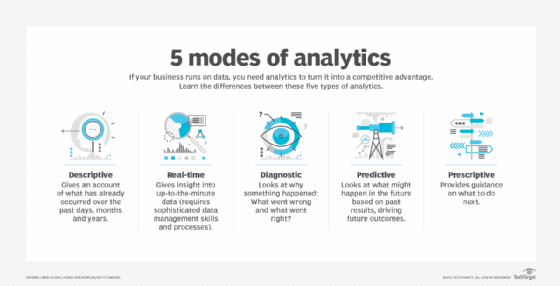8 top predictive analytics tools for 2025
Predictive analytics tools are evolving. Enhanced with AI, easier to use and geared to both data scientists and business users, they're more business-critical than ever.
Advancements in predictive analytics tools have made them more useful and essential to businesses than ever before. Here, we profile eight tools from established leaders and emerging vendors: Altair AI Studio, Alteryx AI Platform, Dataiku, H2O Driverless AI, IBM Watson Studio, Microsoft Azure Machine Learning, SAP Analytics Cloud and SAS.
For readers who might not be familiar with predictive analytics, we start with a brief overview of the field, examining how predictive analytics tools have changed and best practices for choosing the right tool for the job.
What are predictive analytics tools?
The early days of analytics were dominated by analytics that helped enterprises understand what happened in the past: descriptive analytics and diagnostic analytics. Developers commonly used various BI tools to develop these models.
Predictive analytics is a complementary field aimed at forecasting what could happen in the future by analyzing patterns and trends in past and current data. Traditionally, predictive analytics was restricted to a small team of data analysts or data scientists. Predictive modeling was a complex process that could require weeks or months of experimentation with different data sets, exploration of different hypotheses and validations of different prototypes to find a model that showed value.
This has changed, driven by dramatic improvements in the capability of tools designed for both data analytics experts and regular business users, said Carlie Idoine, vice president analyst and chief of research for analytics, data science and AI at Gartner.
The terms used to describe the various tools for building predictive models have also evolved over the years. Today, they are commonly referred to as machine learning (ML), data science, and simulation tools. These tools are used to develop a variety of analytics and AI models for descriptive, diagnostic, predictive and prescriptive analytics.
Predictive analytics is just one aspect of analytics tools. And, in practice, users might not even directly refer to the term when applying it to predictive analytics use cases. For example, a sales manager cares about a better lead scoring algorithm, a marketing manager wants a better click-through rate and the finance team wants to reduce fraud.

Easier to implement
The major shift in analytics is that the current tools make it much easier to tune existing predictive modeling services and create new ones. Idoine cited as an example her early (pre-Gartner) work in building predictive models to improve logistics. Her work then required deep knowledge of how the algorithms worked and also how to code them. Today, enterprises and vendors are exploring various types of automation to reduce the expertise and time required for many of the steps in this process.
"You don't have to be an expert to go in and use these tools anymore," Idoine said.
What used to require weeks of writing code can now be accomplished with a few mouse clicks and a lot of automation on the back end. The new capabilities of automated ML reduce the need to deeply understand how the variables affect each other, automatically choosing the best combination of algorithms for a given task.
"It's a much more automated and augmented process, so it is more accessible," she said.
Finding the right tool for the right job
In choosing the right predictive analytics tools for the job, it is essential first to identify the business and functional needs of your organization's use cases. It could be the case that existing tools for business intelligence, analytics or CRM already support your needs. As noted, many existing business software platforms are now integrating AI and machine learning into BI tools to automate technical tasks, such as data prep, and embed insights into user workflows.
For example, Salesforce has integrated its Einstein Discovery AI technology into Tableau to provide AI-powered analytics to business users and analysts who have domain expertise but lack the technical skills to do advanced analytics or manage ML projects. Similarly, ERP leader SAP has consolidated various predictive analytics capabilities into its SAP Analytics Cloud service, enabling users to build and deploy predictive models without needing deep technical expertise.
Prebuilt models, regression-based tools, ML tools
It is also worth investigating new data science or industry-specific tools that might have a better set of capabilities for your industry or business area. Some predictive analytics tools focus on more generic capabilities that can be applied across all industries, while others are specific to an industry or functional area.
Prebuilt models, templates and toolkits that come with the platforms can dramatically simplify predictive analytics for industry-specific problems using best practices culled from years of experience, Idoine said.
"It is one thing to have technology that's accessible but even better to know how to apply that technology to specific problems within an industry or a functional area of the organization," she explained.
Donncha Carroll, partner at Lotis Blue Consulting -- formerly Axiom Consulting Partners -- underscored the importance of knowing the difference between traditional regression-based predictive analytics tools and ML-based tools.
Regression models essentially represent or encapsulate a mathematical equation that approximates the interactions between the different variables being modeled. ML models use and train on a combination of input and output data, and they use new data to predict the output.
Experts or collaborators?
Finally, it's important to know who will be using these tools, Idoine said. Traditionally, Gartner considered all data science and machine learning platforms as a single market. But Idoine sees a bifurcation in the data science and ML market driven by the needs of hardcore analytics programmers versus citizen data scientists. Hardcore analytics programmers are looking for tools to augment data discovery, data preparation and model development. Citizen data scientists need tools that provide guardrails for common business requirements and support collaborative development across teams. Gartner classifies these two types of tools as "multipersona data science and machine learning platforms" and "data science and machine learning engineering platforms."
Predictive analytics tools for 2025
In alphabetical order, here are eight of the most popular predictive analytics tools to consider.
Editor's note: This unranked list is based on input from Gartner, Forrester Research and other industry experts.
1. Altair AI Studio
Altair AI Studio -- formerly RapidMiner Studio -- includes a comprehensive set of predictive analytics tooling around its core data mining and text mining strengths for both data scientists and noncoding domain experts. The platform's core capabilities simplify extracting data from a diverse set of sources, cleaning it and incorporating it into various predictive modeling workflows. Altair offers free trials of Altair AI Studio and the platform's other core products to help users get started and learn the basics. A notebooks feature simplifies the development of predictive analytics models for both novices and experts alike. The company provides various augmented capabilities for data preparation with Turbo Prep; automated model generation with Auto Model; and automated model operations for deployment, monitoring and management of machine learning models. A generative AI extension enables users to build their own large language models and access open source LLMs on the Hugging Face community. The platform also supports various explainability and governance features when required.
2. Alteryx AI Platform
The vendor's Alteryx Designer, Alteryx Server and Alteryx Analytics products aim to simplify complex analytics processes. Automated data preparation -- collecting, preparing and blending -- is a core strength. The self-service platform offers visual tools, including those for predictive modeling and integration with other ML platforms. Alteryx announced in April 2024 that it was expanding its AI capabilities with Google Cloud's Gemini models.
3. Dataiku
Dataiku's visual and code-based interfaces cater to technical and nontechnical users, giving diverse data teams the ability to generate and share predictions and insights. Described as an end-to-end platform, Dataiku helps users with data preparation tasks, machine learning, visualization and deployment.
4. H2O Driverless AI
Launched in 2017, H2O Driverless AI builds on H2O's popular open source machine learning platform. A commercial product, H2O Driverless AI simplifies AI development and predictive analytics for both experts and citizen data scientists, with custom recipes and integration with open source tools. Of note are various automated and augmented capabilities for feature engineering, model selection, parameter tuning, natural language process and semantic analysis. The company also offers a variety of capabilities that simplify the explainability of predictive analytics models using causal graphs, local interpretable model-agnostic explanations, the Shapley value and decision tree surrogate methods.
5. IBM Watson Studio
IBM became a leading predictive analytics tools vendor with the acquisition of Statistical Package for the Social Sciences (SPSS) back in 2009. SPSS was founded in 1975 and grew into one of the top statistical and analytics packages over the years. IBM continued to innovate the vendor's core capabilities and integrated them into its more modern Watson Studio on the IBM Cloud Pak for Data platform. This consolidated offering combines a broad range of descriptive, diagnostic, predictive and prescriptive analytics functions. The platform simplifies predictive analytics for expert data scientists and improves collaborative data science for business users. The platform also includes various features to enhance responsible and explainable predictive models.
6. Microsoft Azure Machine Learning
Microsoft has long been a leader in various analytics capabilities through its Power BI analytics platform and Excel, which has become the analytics front end of choice for most business users. The company's Azure Machine Learning complements these core tools with capabilities for managing the complete predictive analytics lifecycle. Supporting tools include Azure Data Catalog, Azure Data Factory and Azure HDInsight. The company supports all types of users, from expert data scientists to business subject matter experts. It also provides strong integration with its application development and robotic process automation tooling, which makes it easier to deploy predictive analytics capabilities directly into applications and business workflows.
7. SAP Analytics Cloud
SAP Analytics Cloud (SAC) essentially replaces the SAP Predictive Analytics tool, incorporating BI, planning and predictive analytics into a single suite. SAC is an example of how enterprise application platforms can extend their core offerings to support predictive analytics workflows. SAC is a good choice for enterprises with an extensive SAP deployment, particularly those looking to create predictive analytics for logistics, supply chain and inventory management use cases. The unified platform supports advanced and business users, automating many aspects of data integration, predictive modeling and analysis for nontechnical users. For data scientists and technical users, SAC supports advanced modeling techniques and ML; as a cloud-based platform, it can handle large data volumes and complex calculations.
8. SAS
SAS Institute is one of the oldest statistical analytics tool vendors. The first version of the company's tools began in 1966 as part of a U.S. government initiative to improve data analysis for healthcare. The company was officially launched in 1972 after its government contract ran out. It has continued to innovate various tools used by statisticians and data scientists. The company is a clear leader in all kinds of analytics tools and techniques, including predictive analytics.
More recently, the company has modernized its core tool sets with various data science and machine learning workflows that take advantage of modern data stacks, augmented workflows and simplified deployment. The company has hundreds of tools for various domains. Core offerings for predictive analytics include SAS for Machine Learning and Deep Learning, SAS Viya Programming and SAS Intelligent Decisioning. The company also maintains strong relationships with leading cloud providers and enterprise software platforms to simplify predictive analytics development and deployment across various workflows.
Editor's note: This article was updated in January 2025 to include new tools and technology information.
George Lawton is a journalist based in London. Over the last 30 years, he has written more than 3,000 stories about computers, communications, knowledge management, business, health and other areas that interest him.







